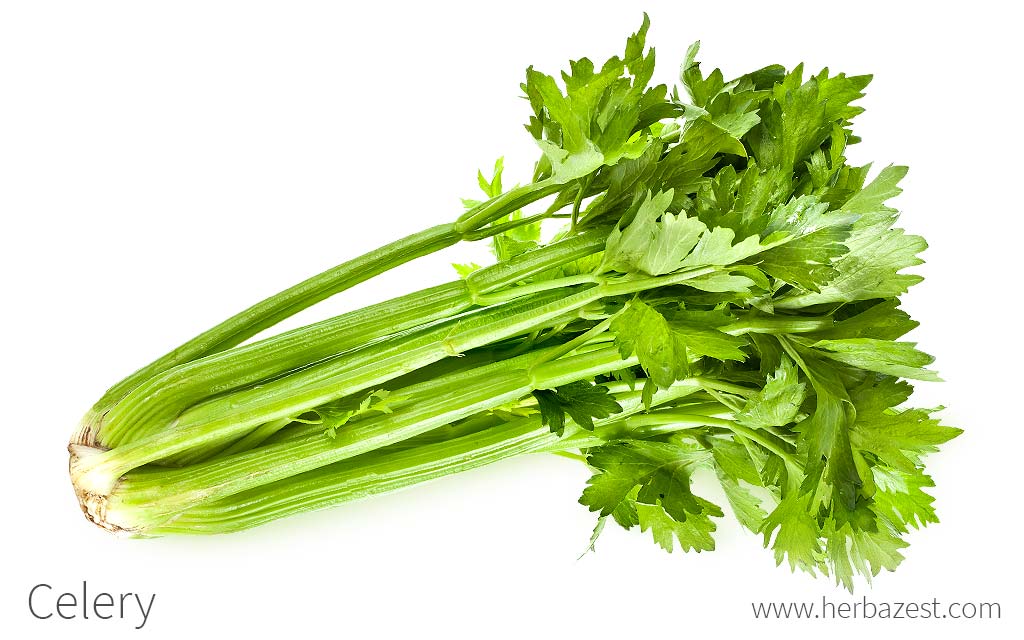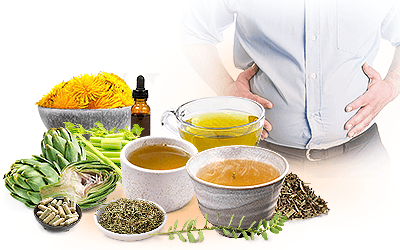Celery, a vegetable originally from saline coastal regions of Europe and Asia, is one of the most popular cooking vegetables and has been used by the culinary world for centuries. Today, is it frequently found in household kitchens, where it is valued for its distinct crunch. However, there is not much awareness of its immense nutritional and medicinal value. Learn more about celery, from its history and medicinal value to its characteristics and growing options.
Celery Medicinal Properties
- Medicinal action Anti-inflammatory, Diuretic
- Key constituents Phthalides, apiin
- Ways to use Capsules, Hot infusions/tisanes, Liquid extracts, Food
- Medicinal rating (2) Minorly useful plant
- Safety ranking Safe
Health Benefits of Celery
Celery is not only a popular ingredient in many dishes, but it has been used medicinally for centuries, relieving a variety of different ailments. Celery's medicinal properties are useful for:
Relieving water retention. Celery works as a diuretic, helping to flush excess fluid from the body.
Reducing inflammation. The anti-inflammatory properties of celery bring relief from joint and muscle pain.
Along with its primary uses, celery has numerous secondary benefits, including:
Alleviating menstrual cramps. The high antioxidant content in celery helps reduce pelvic pain before and during menstruation.
Promoting digestion. A large concentration of insoluble fiber improves digestion and promotes healthy bowel movements.
How It Works
The main reason for celery's varied medicinal properties is its high nutritional value. Celery contains large amounts of antioxidants and flavonoids, mainly apiin.
The most widely described and studied medicinal use of celery is as a diuretic thanks to the action of phthalides present in its stalks, which have also been linked to celery's ability to relieve pelvic pain.1,2 Thanks to its antioxidant content, celery acts as an anti-inflammatory agent.3
Its high insoluble fiber content provides celery with the ability to regulate digestive function and speed up intestinal motility.
Other herbs with anti-inflammatory and diuretic properties are asparagus and maize, while pineapple and rhubarb are examples of digestive herbs for constipation relief.
Celery Side Effects
Celery is safe for most people when consumed orally. However, it may cause allergic reactions and minor skin irritation for those with sensitivities.
Cautions
Individuals who have bleeding disorders or low blood pressure should limit their consumption of celery since it can interact with certain medications. For this reason, eating celery before surgery is not recommended.
Individuals who suffer from kidney problems should not eat celery as it can cause inflammation.
While it is typically safe for women who are pregnant or breastfeeding to eat celery, they should limit their consumption since excessive amounts can contract the uterus and potentially cause miscarriages.

Celery Nutrition
Celery is high in water content and dietary fiber, both of which contribute to a prolonged feeling of fullness. It is also a good source of vitamin K (phylloquinone), which promotes coagulation and healthy bones.
Additionally, celery leaves and stalks provide adequate amounts of vitamin B9 (folate), vitamin B5 (pantothenic acid), and potassium, along with small amounts of other B-complex vitamins, mainly B2 (riboflavin) and B6 (pyridoxine).
100 grams of celery stalks provide 14 calories and 6% of the daily value for dietary fiber.

How to Consume Celery
- Edible parts Seed, Stem
- Taste Mild
Commonly consumed in its raw state, celery has numerous medicinal benefits in both its food and medicinal forms. Learn the different ways celery could benefit your health:
Natural Forms
Raw. One of the most popular methods of consumption, raw celery stalks work as a diuretic, promoting urination and eliminating water retention.
Cooked. When cooked, celery retains many of its health benefits that have made it so well-regarded. In this form, celery can relieve joint pain due to its anti-inflammatory properties.
Dried seeds. In one of its most ancient medicinal forms, celery seeds have numerous properties. One of celery's main modes of action is as a diuretic, which helps stimulate urination and relieve water retention in the body.
Infusion. When brewed into a hot tea, a celery infusion can relieve muscle cramps by lowering the inflammation of the pelvic muscles.
Herbal Remedies & Supplements
Liquid extract. When made into a liquid extract, celery has numerous medicinal properties, including promoting digestion due to its high insoluble fiber content.
Capsules. In its most potent medicinal form, celery capsules have numerous health benefits. Because of its anti-inflammatory properties, celery can relieve muscle and joint pain in the body when taken in capsule form.
Growing
- Life cycle Annual
- Harvested parts Roots, Leaves, Stem
- Light requirements Full sun
- Soil Peaty
- Soil pH 6.1 – 6.5 (Slightly acidic)
- Growing habitat Coastal regions
- USDA Plant Hardiness Zones 5a, 5b, 6a, 6b, 7a, 7b, 8a, 8b, 9a, 9b, 10a, 10b, 11a, 11b
- Pre-germination seed treatment Soaking
- Potential insect pests Aphids
- Potential diseases Aster yellows
While it is grown in nearly every region in the world, celery is one of the trickier vegetables to grow. When planted from a seed, celery should always begin its life indoors to increase its chances of survival. Of course, it is also a notoriously difficult plant to transport. While it can be sensitive and there are many requirements, growing celery can be worthwhile for any gardener. For tips on how to help this vegetable thrive, follow the growing guidelines below:
Growing Guidelines
Celery should be planted in rich, moist soils. In fact, before planting, working organic fertilizer or compost into the soil is recommended. Mulch and water directly after planting.
Celery can tolerate saline soils, and it is often planted in deep trenches after reaching between 6 - 8 inches (15 - 20 cm) high.
Celery prefers cool, temperate climates with temperatures ranging from 55 to 70 F (12 to 21 C), especially in its early stages of growth.
Celery is a heavy feeder. It also requires lots of water. Make sure to provide plenty of water during the entire growing season, especially during hot, dry weather. If celery does not get enough water, the stalks will be dry and small.
Add plenty of compost and mulch around the plants to retain moisture. It is also important to fertilize regularly to help the soil retain moisture and nutrients.
Once it is transported to the field, celery should be planted in rows leaving eight inches (20 cm) between each plant and two to three feet (60 - 90 cm) between each row.
Harvesting should be done by cutting the plant just below the soil line. The darker the stalks become, the more nutrients they will contain.
Additional Information
- Other uses Repellent
Plant Biology
Celery is a marshland variety of Apiaceae plant that has been cultivated for culinary and medicinal purposes for centuries. Depending on its cultivar and possibly its location, celery is used for its stalks, leaves, or hypocotyl, as well as seeds and extracts. Celery leaves are pinnate to bipinnate with rhombic leaflets that are 1 - 2.5 inches (3-6 cm) long and .5 - 2 inches (2--4 cm) wide. The flowers that bloom are creamy-white and are produced in dense compound umbels.
Classification
Celery, scientifically known as Apium graveolens, is a member of the Apiaceae family, which contains mostly aromatic plants, including 3,700 species spread over 434 genera. The Apiaceae family is commonly known as the carrot or parsley family, and it contains many other economically-important herbs, such as coriander, dill, and angelica, as well as carrots and parsley.
Varieties and Subspecies of Celery
Since the days that celery first began being cultivated, four different varieties have been identified. These are leaf celery (var. secalinum), which produces a thin stalk and aromatic leaves; celeriac celery (var. rapaceum), which is identifiable by its large root; stalk celery (var. dulce); and plain celery (var. graveolens), which touts long, crunchy stems.
Historical Information
Celery was first domesticated by humans as far back as 1300 BCE, when it was grown as a food crop in Asia. It is believed that celery was used as a food commodity during the lifetime of Egyptian pharaoh Tutankhamen, who died in 1323 BCE, as celery leaves were found in his tomb. Also, celery dating back to the 7th century BCE was recovered in the Heraion of Samos. Homer mentions celery growing wild in the city of Troy, and it is depicted surrounding the cave of Calypso. Celery finally found its way into European cooking in the 1600s.
Economic Data
Celery is an economically important vegetable. It is available commercially as seeds, seed oil, whole vegetables, and oleoresin. India is the biggest exporter of celery, exporting over 5,000 metric tons (5,510 short tons) a year. The price of Indian celery, which accounts for half of the world's market, has remained stable. Yearly consumption of celery in the U.S. is seven pounds (3 kg) per capita. California and Florida account for 90% of the U.S. production of celery.
Popular Beliefs
Celery had numerous uses in ancient Rome and Greece. In ancient Rome, celery was considered an aphrodisiac, attracting women to men. In ancient Greece, it was used as a bouquet of flowers to reward the winners of the ancient Olympic games.
Sources
- Critical Reviews in Food Science and Nutrition, Chemistry, technology, and nutraceutical functions of celery (Apium graveolens L.): an overview
- Domestication of Plants in the Old World, p. 202
- Environmental Archeology, Wild and Cultivated Vegetables, Herbs and Spices in Greek Antiquity, 2005
- International Archives of Integrated Medicine, A Review of Apium graveolens (Karafs) with special reference to Unani Medicine
- Purdue University, Celery
- Shahrekord University of Medical Sciences, A review on medicinal plant of Apium graveolens
- Encyclopedia of Herbal Medicine, p. 64
- Germplasm Resources Information, Taxon: Apium graveolens L.
- The FASEB Journal, Cross-reactive N-glycans of Api g 5, a high molecular weight glycoprotein allergen from celery, are required for immunoglobulin E binding and activation of effector cells from allergic patients, 2003
Footnotes:
- Preventive Nutrition and Food Science. (2016). Effects of Apium graveolens Extract on the Oxidative Stress in the Liver of Adjuvant-Induced Arthritic Rats. Retrieved December 5, 2022, from: https://www.ncbi.nlm.nih.gov/pmc/articles/PMC4935245/
- International Journal of Current Microbiology and Applied Sciences. (2015). Antioxidant and antimicrobial activity of celery (Apium graveolens) and coriander (Coriandrum sativum) herb and seed essential oils. Retrieved December 5, 2022, from: https://www.researchgate.net/profile/Esraa-Ahmed-Mohamed-Mousa/publication/323772795_Antioxidant_and_antimicrobial_activity_of_celery_Apium_graveolens_and_coriander_Coriandrum_sativum_herb_and_seed_essential_oils/links/5aaa4db3a6fdccd3b9baeb90/Antioxidant-and-antimicrobial-activity-of-celery-Apium-graveolens-and-coriander-Coriandrum-sativum-herb-and-seed-essential-oils.pdf
- Preventive Nutrition and Food Science. (2018). Inhibitory Effects of Apium graveolens on Xanthine Oxidase Activity and Serum Uric Acid Levels in Hyperuricemic Mice. Retrieved December 5, 2022, from: https://www.ncbi.nlm.nih.gov/pmc/articles/PMC6047868/













